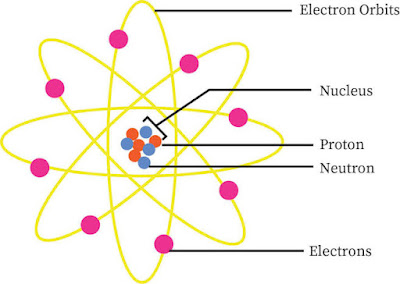Class 9 Science
Chapter 1 Matter in our surroundings
Introduction
→ Since early times human beings have been trying to understand their nature. Early Indian philosopher classified matter into five basic elements. the“Panch Tatva”– air, earth, fire, sky and water. According to them, living as well as non living things are made up of these elements.
→ Now a days, scientists evolved to types of classification of matter – physical properties and chemical nature.
Physical Nature of Matter
→ Matter is made up of particles. All matter constitute of very small particles. These small particles are called atoms.
→ These particles of matter are too small so they cannot be seen by naked eyes or simple microscope.
→ Particles of matter are continuously moving as they posses kinetic energy, with the increase of temperature kinetic energy of particles also increases so particle moves faster.
Diffusion
→ Brownian Motion: The zig-zag or random path travelled by the particles of matter is called Brownian motion.
Change of State of Matter
→ The phenomenon of change from one state of matter to another, and then back to the original state is called the interconversion of states of matter.
→ Matter Can Change its State. Water can exist in three states of matter:
• Solid as ice
• Liquid as water
• Gas as water vapour
Effect of Temperature
→ On increasing the temperature of solids, the kinetic energy of the particles increases which overcomes the forces of attraction between the particles thereby solid melts and is converted to a liquid.
→ The temperature at which a solid melts to become a liquid at the atmospheric pressure is called its melting point. The melting point of ice is 273.16 K.
The process of melting, that is, change of solid state into liquid state is also known as fusion.
• Latent heat
The hidden heat which breaks the force of attraction between the molecules is known as the latent heat. Since, the heat energy is hidden in the bulk of the matter, it is called latent heat.
• Latent heat of fusion
→ The heat energy required to convert 1 kilogram of a solid into liquid at atmospheric pressure, at its melting point, is known as the latent heat of fusion.
→ The temperature at which a liquid starts boiling, at atmospheric pressure, is called its boiling point.
→ Boiling is a bulk phenomenon. Particles from the bulk of the liquid gain energy to change into the gaseous state. For example, boiling point of water is 100° C. (or 100° C = 273 + 100 = 373 K)
• Latent heat of vaporisation
→ The heat energy required to convert 1 kilogram of liquid into gas, at atmospheric pressure, at its boiling point, is known as the latent heat of vaporisation
→ The process, in which a gas, on cooling, turns into a liquid at a specific temperature is called condensation or liquefaction. Formation of clouds is due to the condensation of water vapour from the Earth’s surface.
→ The change of state of a substance directly from a solid to gas, without changing into the liquid state (or vice versa) is called sublimation.
→ The temperature at which the state of a substance changes from a liquid to a solid is called the freezing point of that substance.
→ When a solid melts, its temperature remains the same because heat gets used up in changing thestate by overcoming the forces of attraction between the particles. It is considered that it getshidden into the contents of the beaker and is known as the latent heat.
→ Water vapour at 373 K have more energy than water at the same temperature because
Effect of change of pressure
→ Gases can be liquefied by applying pressure and reducing the temperature. When a high pressure is applied to a gas, it gets compressed and if the temperature is lowered, the gas is liquefied.
→ Solid CO2 gets converted directly to gaseous state on decrease of pressure to 1 atmosphere without coming into liquid state. This is the reason that solid carbon dioxide is also known as dry ice.
Evaporation
→ The process of conversion of a substance from the liquid state to the gaseous state at any temperature below its boiling point is called evaporation or vaporisation.
→ Evaporation is a surface phenomenon.
• Factors affecting the rate of evaporation
→ The rate of evaporation increases on increasing the surface area of the liquid.
→ The rate of evaporation increases with an increase in temperature.
→ Decrease in the humidity increases the rate of evaporation.
→ An increase in the wind speed increases the rate of evaporation.
• Evaporation causes cooling
→ The particles of liquid absorb energy from the surrounding to regain the energy lost during evaporation. This absorption of energy from the surroundings make the surroundings cold.
→ Lately, scientists are talking about five states of matter or five phases of matter. These are-solids, liquids, gases, plasmas and the Bose–Einstein condensate.
Plasma
The state consists of super energetic and super excited particles. These particles are in the form of ionised gases. The fluorescent tube and neon sign bulbs consist of plasma.
Bose-Einstein Condensate
→ Indian physicist Satyendra Nath Bose made a study regarding the fifth state of matter. Based on his study, Albert Einstein predicted a fifth state of matter called the Bose-Einstein Condensate.
→ The Bose-Einstein Condensate or BEC is formed by cooling a gas of extremely low density to super low temperatures.
Some Important Measurements
→ The SI unit of mass is kilogram (kg).
→ The SI unit of volume is cubic metre (m3). The common unit of measuring volume is litre (L) such that 1L = 1 dm3, 1L = 1000 mL, 1 mL = 1 cm3.
→ Kelvin is the SI unit of temperature, 0° C = 273.16 K. For convenience, we take 0° C = 273 K after rounding off the decimal. To change a temperature on the Kelvin scale to the Celsius scaleyou have to subtract 273 from the given temperature, and to convert a temperature on the Celsius scale to the Kelvin scale you have to add 273 to the given temperature.
→ Atmosphere (atm) is a unit of measuring pressure exerted by a gas. The unit of pressure is Pascal (Pa): 1 atmosphere = 101325 Pa. The pressure of air in atmosphere is called atmospheric pressure. The atmospheric pressure at sea level is 1 atmosphere, and is taken as the normal atmospheric pressure.




.png)










No comments:
Post a Comment